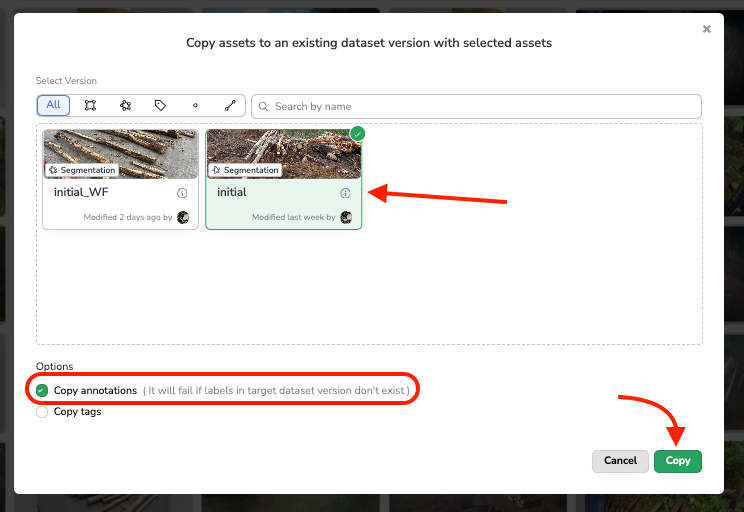Dataset - Fork a Dataset Version
We have already seen previously in the documentation how to create a Dataset Version from a selection of Data in the Datalake.
But for many different reasons, you might be willing to modify a DatasetVersion. In order to ensure traceability and avoid losing the history of your work, it is highly recommended to leverage the Picsellia Dataset versioning system by forking a new DatasetVersion from the to-be-modified one.
Fortunately, Picsellia embeds features that will allow you to fork easily a DatasetVersion or copy Asset to a DatasetVersion to another.
1. Fork a DatasetVersion
DatasetVersionFirst of all, you need to access the DatasetVersion you want to fork.
Once in it, you have the possibility to fork the entire DatasetVersion or a subset of it. Depending on your needs, you can leverage the Assets selection features to select the Asset that need to be embedded in the new DatasetVersion.
Once the Asset are selected, you just need to click on Dataset > Create New Dataset Version.

Create New Dataset Version button
A modal will open, in order to personalize the fork. You can for sure give a name to the new DatasetVersion and decide what needs to be embedded in addition to the Asset:
- Copy Label, which will create a new
DatasetVersionwith the same Detection Type andLabelmapthen the initial one - Copy Label and Annotation, which will create a new
DatasetVersionwith the same Detection Type,Labelmapthen the initial one. TheAnnotationrelated to theAssetof the newDatasetVersionwill also be copied. - Copy Tags, which will copy the
AssetTagin the newDatasetVersionand attach them to the newAssetthe same way as the initial one.
Obviously, several options can be checked during the fork:

Fork options
To finalize the fork, you just need to click on Create.
Once the fork is launched, its completion can be tracked from the Jobs panel.
2. Copy an Asset to another DatasetVersion
Asset to another DatasetVersionIn case you want to copy an Asset from a given DatasetVersion to another already existing one of your Dataset, you can leverage the Copy to an existing dataset version button.
To use it from any DatasetVersion, you simply need to select the to-be-copied Asset and click on Dataset > Copy to an existing dataset version.

Then, a popup will open allowing you to select the DatasetVersion contained in the Dataset to which the selected Asset will be copied.
You can also choose to copy only the Asset or embed either the related Annotation or AssetTag.
Finally, you can click on Copy to make the copy happen.

Ensure Detection Type and Labelmap consistencyIn case you embed
Annotationin your copy, you must ensure that the source and destinationDatasetVersionhave the same Detection Type and that the Labelmap of the sourceDatasetVersionis included the destination's one.
Updated 7 months ago